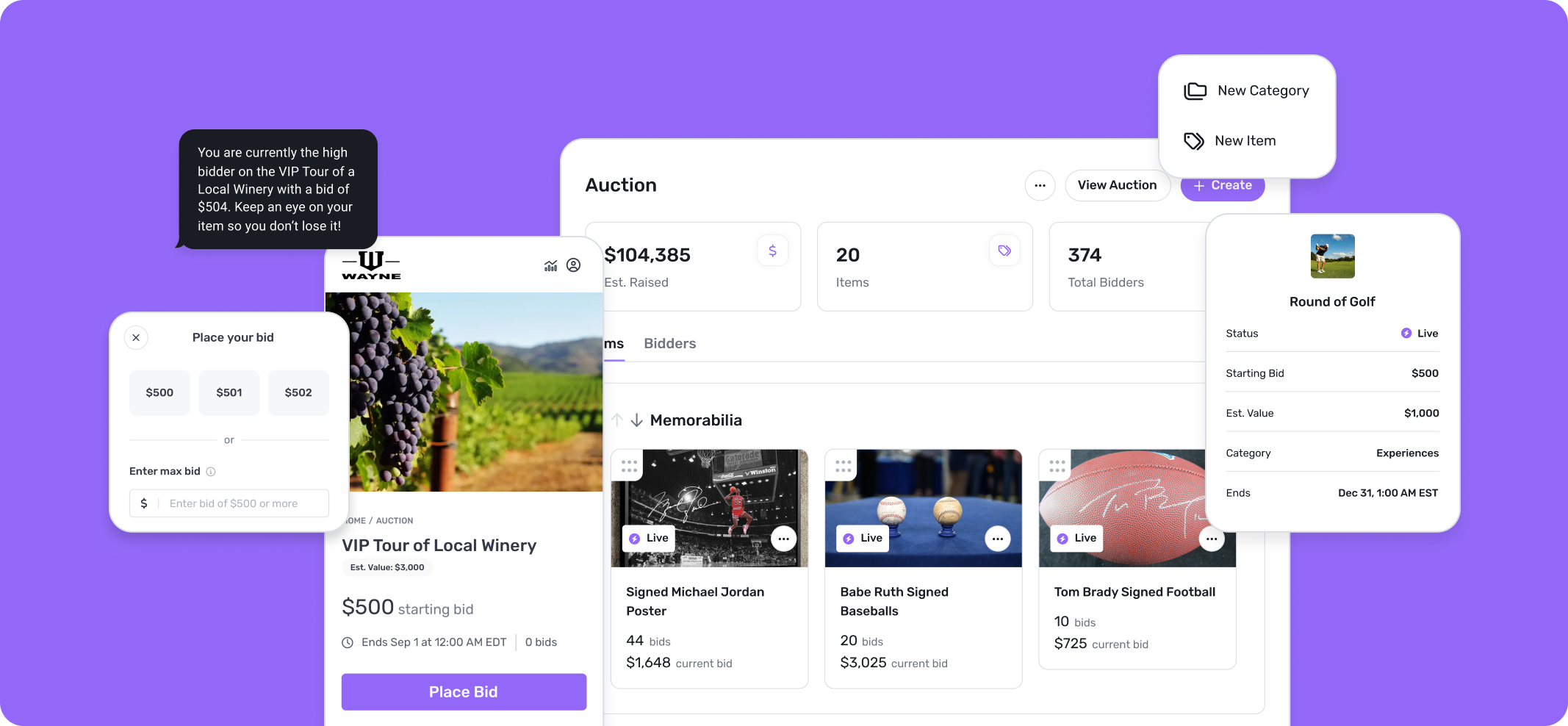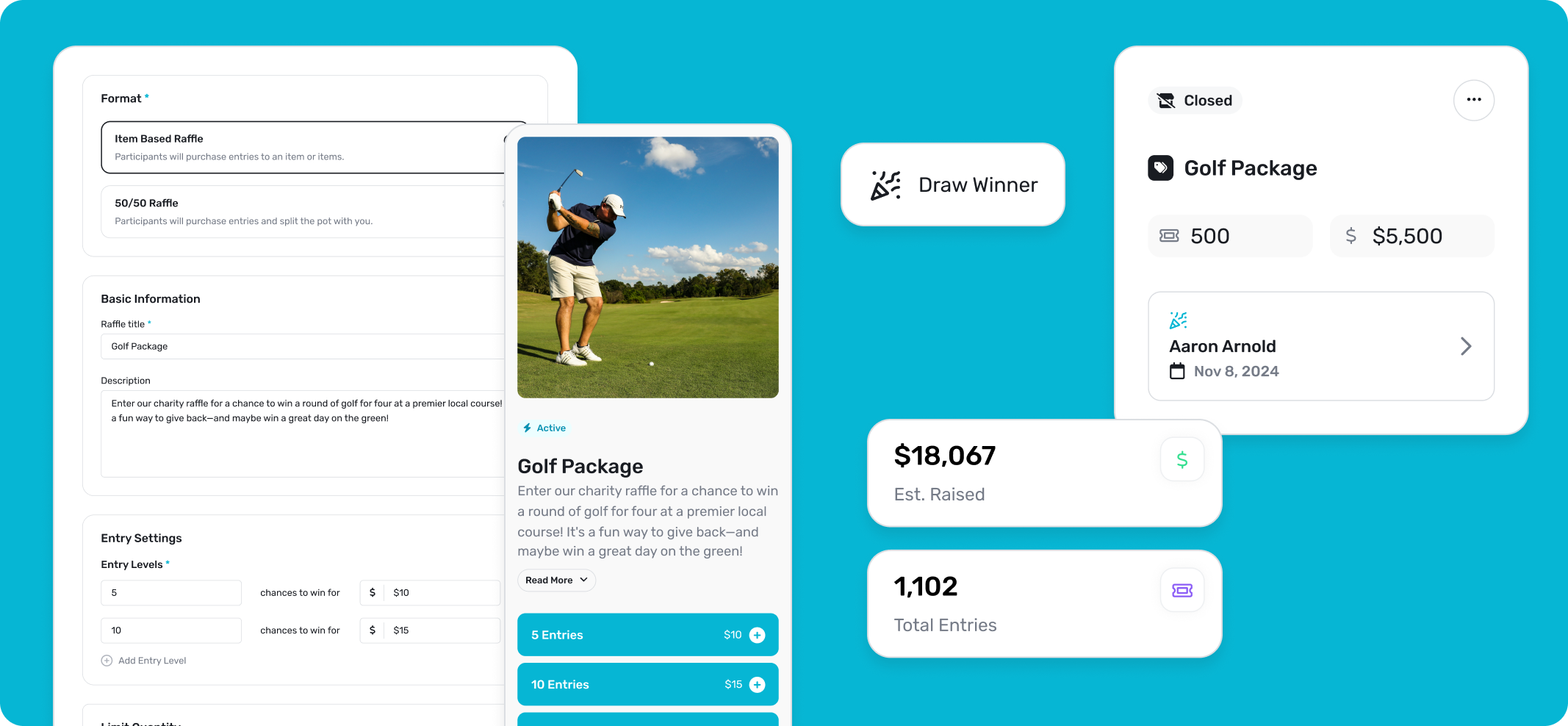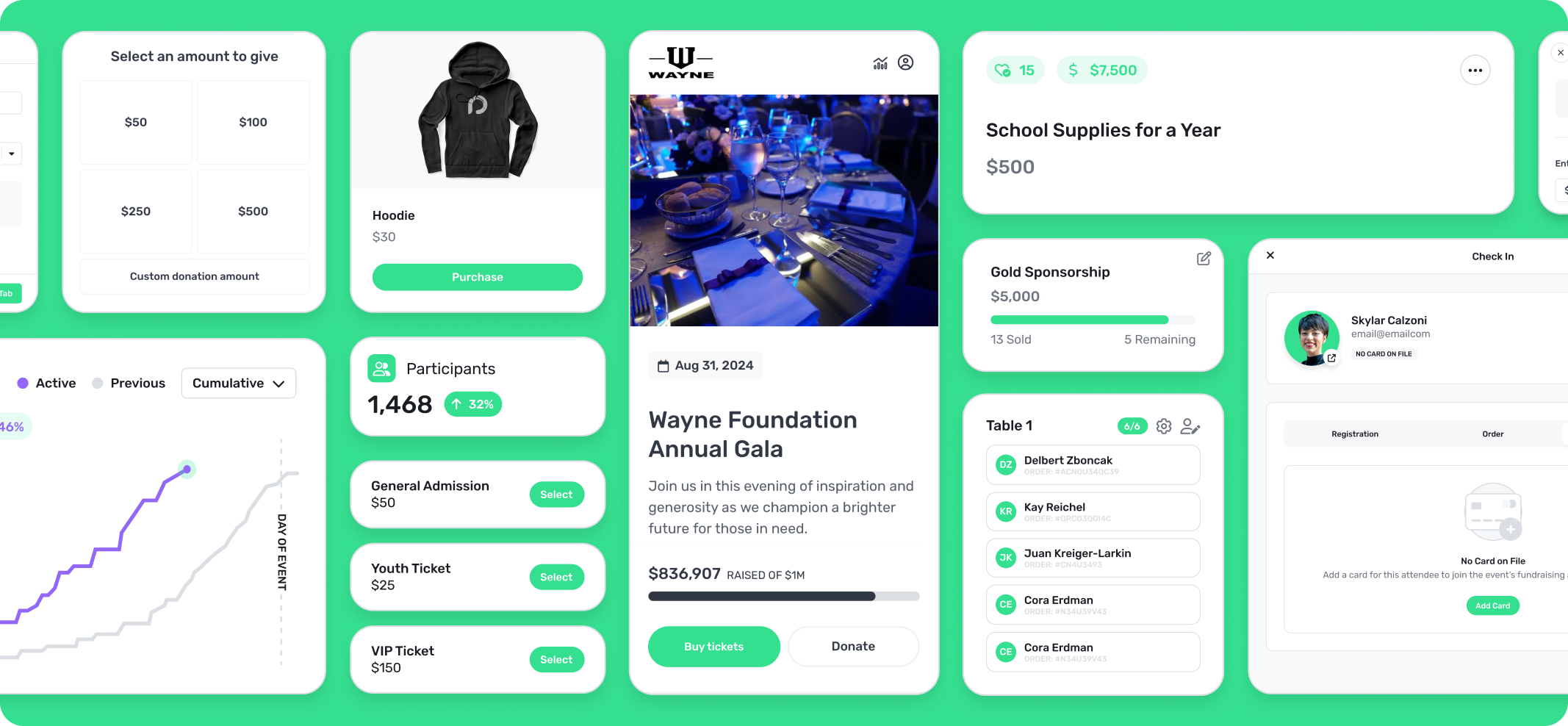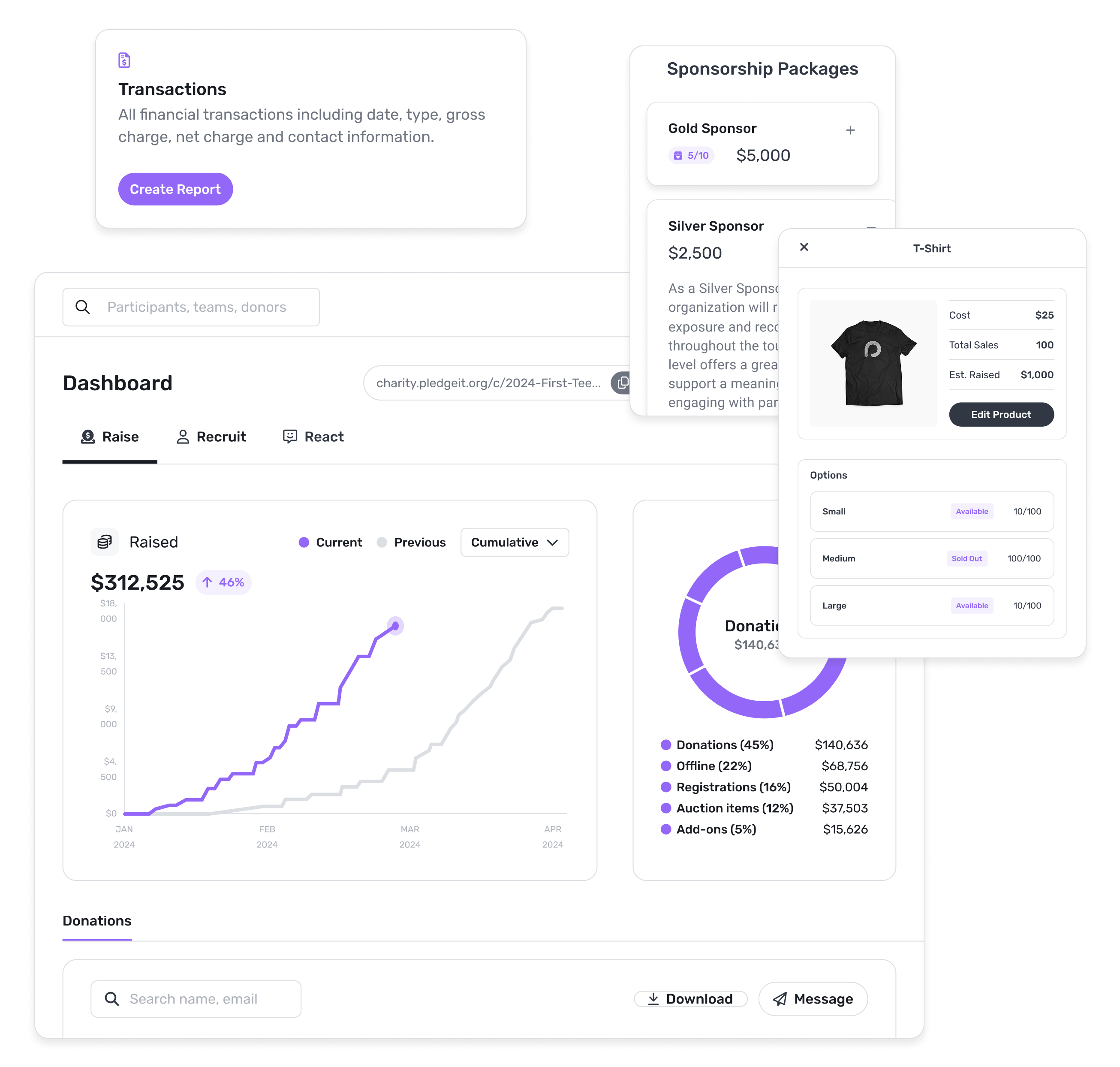Silent auction or online raffle? If you're researching how to run a silent auction, you're really asking a bigger question: What will resonate with your specific donors, feel authentic to your mission, and bring in both dollars and visibility?
Both are proven fundraisers, but they're not interchangeable. Each one attracts different donors, requires different resources, and delivers different results.
By the end of this guide, you’ll know how to run silent auctions and online raffles, compare each format’s strengths and limitations, and choose the approach that fits your goals. Keep in mind, both silent auctions and online raffles can run exclusively online, expanding your reach beyond one-off in-person events.
Silent Auction or Raffle? Understanding the Key Differences
Silent auctions and raffles aren't new fundraising ideas, but the way nonprofits run them has evolved. Paper bid sheets and raffle ticket stubs have given way to mobile apps and online platforms. Here's what each format looks like today.
What Is a Silent Auction?
Silent auctions are bidding competitions where participants browse unique items or experiences and attempt to place the highest winning bid. Unlike live auctions, guests browse at their own speed, returning to check on items and raise bids when they choose—whether using paper bid sheets or digital platforms. The traditional silent auction uses paper bid sheets for bidding, but many events now supplement or replace this format with mobile bidding technology. Platforms like Pledge It offer a silent auction tool that lets supporters bid from their phones, receive outbid notifications, and pay instantly, eliminating the chaos of paper sheets and manual payment collection.
Silent auctions are often held during galas, cocktail receptions, golf tournaments, and other fundraising events. The bidding process creates genuine engagement with your cause. With mobile platforms like Pledge It, supporters can track their bids from their phones, get notified when they're outbid, and decide in the moment to increase their support. The emotional investment in both the item and your mission drives participation and giving.

The key is offering items people can't just order online—concert tickets to sold-out shows, custom artwork created for your cause, behind-the-scenes experiences, or even that primo parking spot everyone wants. When supporters see something unique tied to an organization they believe in, they're motivated to give more generously than they might through a simple donation.
What Is an Online Raffle?
Online raffles make fundraising accessible to everyone. Supporters purchase numbered tickets at fixed prices—typically with bundle incentives like "1 for $10, 3 for $25, 10 for $50"—and each ticket represents an entry into your prize drawing. The beauty of this format? Every supporter can participate at a level that works for their budget, and everyone has an equal chance at winning regardless of their contribution size.
Unlike auctions where supporters compete and monitor bids, raffles keep things simple. People know exactly what they're spending upfront, buy their tickets, and that's it. With Pledge It, raffle ticket sales are sold online, payments process instantly, and winner selection is randomized, taking the administrative burden off your team.

This simplicity makes raffles perfect as an additional revenue stream. They run quietly in the background during events or other campaigns, requiring minimal management while opening participation to supporters who might not bid in an auction. The anticipation builds toward a single exciting moment: the drawing, which can happen live at your event or streamed online for everyone to watch.
Quick Comparison
Silent auctions take a little more time to plan, with two to three months of planning for procurement and logistics, plus dedicated volunteers to pull it all off. The payoff? High engagement from your established donors who enjoy the competitive energy of bidding. These work best when you've got a captive audience at your gala or golf tournament ready to actively participate throughout the event.
Go this route when you have unique, high-value items nobody can buy online (exclusive experiences, signed memorabilia, VIP access), your revenue goal exceeds $10,000, and you want the auction to double as a networking opportunity that gets people talking about your mission.
On the other hand, online raffles move much faster. You can launch in three to six weeks with minimal volunteer support since the technical side is straightforward—just ticket sales and a drawing tool. The low-commitment format appeals to a broader audience beyond your core donors. Supporters buy their tickets and they're done, making raffles perfect for passive fundraising that runs alongside other activities. Choose this approach when you need to raise $5,000 to $15,000 quickly with minimal overhead, you have one to three incredible prizes that will generate widespread excitement, and your supporters prefer more straightforward giving.
Bottom line: Silent auctions create an engaging experience that requires active participation, while raffles offer an accessible option that practically runs itself.
How to Run a Silent Auction: Step-by-Step Process
Strategic planning, compelling items, and the right digital tools take the chaos out of silent auction management. Here's how to run a silent auction that actually raises money, from initial planning through post-event follow-up.
Planning Phase (4-6 Weeks Out)
Establish clear and specific fundraising goals, like how much you need to raise. For example, “We need to raise $30,000 to fund a new outreach program” is the story your team can use to secure donations and know how many auction items you’ll need and at what value.
Next, nail down your format. Are you adding a silent auction to your annual gala? Running it entirely online? Creating a hybrid where both in-person and remote supporters can participate? Your format determines everything from tech requirements to volunteer needs, so lock this in early.
Once you’ve set your format, build your team with clear ownership. You need someone who owns procurement (and isn't afraid to ask for big donations), someone running marketing and social media, someone managing the tech platform and troubleshooting, and someone handling logistics and post-event follow-up. When everyone knows exactly what they're responsible for, the event will run more smoothly and feel more effortless.
For your platform, look for mobile bidding, integrated payment processing, and real-time auction management. Having everything in one system prevents the nightmare of juggling multiple tools on event night. The Jordan Thomas Foundation (JTF) learned this firsthand.
The team initially planned to use Pledge It just for registration and sponsorships, but when it decided mid-planning to add both silent and live auctions, everything stayed in one platform. As April De Leon from JTF noted, "If we had gone with anybody else, we wouldn't have been able to switch gears like we did."
Getting Items People Actually Want to Bid On
Your auction items determine whether people eagerly bid or politely walk away. Focus on securing quality items across different price points, with special attention to experiences and access your supporters can't buy elsewhere.
What actually moves the needle? Think about what your specific donor base values. Exclusive access always performs well—a board president’s parking spot for a year, private facility tours, early enrollment privileges, or behind-the-scenes experiences. These items spark competitive bidding and feel deeply connected to your mission. Items with mission connection resonate deeply, like artwork created by those you serve, naming opportunities, or chances to see your impact firsthand. Even local perks work when they're special, such as restaurant gift cards for that impossible-to-book place hit differently than chain restaurants.
Before you start procurement, survey your supporters about what they'd actually bid on. Their answers might surprise you. Sometimes the most popular items aren't the most expensive ones.
When asking for donations, do the thinking for them. Instead of "Can you donate something?" try "We're looking for a wine tasting for eight at your vineyard" or "Could you offer a foursome at your golf club with lunch included?" Specific asks get better results because donors don't have to guess what would work. Include details about your audience size, demographics, and how you'll promote their business to make saying yes easier.
Pro tip: Create a simple one-page document showing past successful bid ranges, expected attendance, and marketing reach. Donors want to know their contribution will be valued and promoted properly.
Choosing Tech That Won't Let You Down
The right fundraising platform empowers your team to run professional events that engage supporters and raise more money. Here's what to look for when choosing event technology that grows with your organization.
Your platform should handle your entire event lifecycle:
- Registration and ticketing with custom questions and early bird pricing
- Sponsorship levels with proper recognition and benefits tracking
- Multiple fundraising activities running at once (auctions, raffles, donations)
- Check-in that captures credit cards for faster checkout
- Real-time reporting so you know what's working during your event
Mobile accessibility drives participation. Supporters can register, bid, buy raffle tickets, and donate from their phones instantly, which means no app downloads or complicated accounts needed. The same platform works for in-person guests scanning QR codes and remote supporters at home, expanding your reach beyond the ballroom.
Smart payment processing creates a better experience for everyone. Platforms that capture cards at check-in, process payments automatically when auctions close, and handle checkout efficiently save hours of work.
Live displays build excitement throughout your event. Showing auction progress, Fund a Need totals climbing toward goals, and raffle ticket sales creates energy that drives more giving. Your team needs dashboards to monitor activity and adjust strategy in real-time.
Pledge It brings all these capabilities together in one platform. From registration through receipts, everything stays connected without jumping between different systems or losing data along the way.

How to Run an Online Raffle
Ever run a raffle with handwritten tickets, manual tracking, and announcing winners who've already left your event? Online raffles solve these headaches with automated ticket sales, digital tracking, and winner notifications, letting you focus on your mission instead of chasing down paper ticket stubs.
Start with the basics: Decide on your prize, your timeline, and where the raffle will live within your larger campaign or event
Making Your Raffle Work for You
Once you've cleared the legal hurdles, focus on what drives ticket sales.
Your raffle won't sell itself. You need a strategic promotion plan that builds momentum from launch through drawing day.
Week 1: Announce across all channels simultaneously. Send a dedicated email to your full list, post on all social platforms, and add prominent banners to your website. Focus your messaging on the prize value and impact: "Win a $5,000 vacation while funding music therapy for 20 children."
Week 2: Share updates about ticket sales ("We're 40% to our goal!"), spotlight the prize with photos and details, and create FOMO with messages like "Over 500 tickets already sold." This is when you activate your board and volunteers to share with their networks.
Final week: Daily countdown posts, frequent updates on the final day, and "last chance" messaging across all channels. Offer incentives like bonus entries for social shares or early bird specials for the first 100 buyers.
A few smart promotional tactics to consider:
- Turn participants into promoters with bonus entries—five extra entries for sharing on social media, three for tagging friends, 10 for selling tickets to others. These incentives expand your reach organically while keeping costs down.
- Use compelling visuals everywhere. Professional photos of your prizes, progress thermometers showing ticket sales, and countdown graphics all drive action. Create a simple shareable graphic your supporters can post to their own social media.
- Partner with prize donors for cross-promotion. If a local resort donated the vacation package, they'll often share your raffle with their audience, too.
Set Your Raffle Up for Success: The Tech That Makes It Easy
A strong online raffle needs technology that works for your team—not against you. Choose a solution built for nonprofits, simple for supporters, and flexible enough to fit your workflow. Here’s what to look for (and that your platform should support)
- Quick setup: Create your raffle in minutes. Set ticket types and pricing with minimal fuss.
- Mobile-first checkout: Supporters should be able to buy tickets easily on smartphones or tablets.
Flexible entry options: Sell standalone tickets or bundle them with event registration. - Effortless winner selection: No spreadsheets. Just a clear, documented draw.
Integrated campaign flows: Your raffle tool should live alongside registration and event pages.
Before you go live, run a quick operations check:
- Test the full ticket-purchase flow (desktop + mobile) to make sure everything’s intuitive.
- Ensure your raffle entry page clearly states rules, prize details, drawing method, eligibility and notification process.
- Upload your prize visuals, craft branded assets (graphics, emails, buttons) and prepare your launch messaging.
- To maximize sales, make raffle entries visible and easy to add during online registration by positioning them as an upsell option in your checkout flow, and verify that the payment processing and ticket count tracking work seamlessly.
- Make sure you have a plan for drawing winners, notifying winners and publicly closing the raffle (to build credibility).
Running the Drawing
When it’s time to pick your winner, use your platform’s built-in randomizer to ensure a fair, transparent draw. You can record the process—either with a screen capture or a short livestream—so you have documentation and content to share.
Notify winners immediately via email and phone. Then close the loop publicly: Post the winner announcement across your channels, thank every participant, and share how much was raised and what the funds will support. This final communication is what turns one-time raffle buyers into long-term supporters.
Silent Auction vs Raffle: Which Format is Right for Your Organization?
You’re still weighing your options: silent auction vs. online raffle. Which one aligns with your status quo? Here’s what you can begin to consider.
If you’re considering a silent auction, remember that you can also host a virtual silent auction as part of a virtual event. This approach increases accessibility, allowing remote participants to join and engage in online bidding from anywhere.
Choose a Silent Auction If...
- Your donors have higher giving capacity and enjoy in-person or online competition. The bidding process naturally invites supporters to increase giving.
- You want to create a lively and vibrant networking experience. Silent auctions make for great conversation starters.
- You have access to high-value items that no online supplier can easily deliver. Think exclusive wining and dining experiences, autographed sports memorabilia, VIP passes, or custom packages.
- Your revenue goal is $10,000 or more. Well-planned and organized silent auctions, with effective silent auction planning, can generate higher returns than raffles.
- You have two to three months to plan for procurement, marketing, and platform setup.
- You want donor engagement that stems from natural conversation starters. Competitive bidding creates an emotional pull towards your mission.
Choose an Online Raffle If...
- You want to reach a wide audience without any major commitments. Online raffles have a low barrier to entry, inviting supporters at all giving levels with affordable ticket prices.
- You need to fundraise quickly with minimal setup time. Go live with your raffle in three to six weeks when in need of a last-minute fundraising solution.
- Your donors favor fundraisers that are low in commitment. They can buy tickets, wait for the drawing, without tracking bids or competing with others.
- You want an easy, additional fundraising format that can run itself. Raffles need little attention once they're live, unlike silent auctions that require more coordination.
- You have one to three compelling prizes that are guaranteed to sell out tickets. Quality is key! One mind-blowing reward can be all it takes to reach as many people as possible, and hit your goals.
- Your revenue goal is $5,000 to $15,000 with little overhead. Online raffles can deliver solid returns with less logistical complexity.
Plot Twist: You Don't Have to Choose
If you’re feeling ambitious, you can run a silent auction and an online raffle. Plenty of organizations run silent auctions during their main event, along with a raffle. Silent auctions attract committed supporters, and raffles pull in new donors or long-time lurkers—a nice addition for auctions. Continue selling tickets during cocktail hour or at the registration table.
Consider a year-round approach where you run silent auctions during big events and launch raffles during slower fundraising periods to keep revenue flowing even during quiet months. Leveraging online events can help maintain engagement and fundraising momentum throughout the year, allowing supporters to participate virtually and keeping your audience connected. Platforms like Pledge It make managing multiple formats simple by containing tool functionality for auctions, raffles, ticketing, and donations in one system.
Common Mistakes to Avoid (With Either Format)
Keep these avoidable mistakes on hand to save you time, money, and stress.
- Late promotion. Give yourself at least four to six weeks of marketing runway to promote your silent auction. With raffles, give yourself three to four weeks minimum. Think of it this way: Your supporters need time to plan, budget, and spread the word to their network.
- No mobile experience. These days, participants can browse, bid, or buy tickets from their phones. If your platform isn’t mobile-optimized, you’re missing out on donations.
- Complicated registration. Any unnecessary text boxes in your checkout process can cost you participants, so keep it simple with fields for name, email, and payment information.
- Boring items, experiences, or prizes. Bland gift baskets and everyday gift cards won’t cut it at a silent auction. Special experiences and high-value items will.
- Zero follow-up. Every single participant deserves to feel appreciated, regardless of their bidding results. Promptly notify winning bidders and ensure their payments and transactions are handled smoothly. Engage your auction guests and event attendees after the event by gathering feedback and insights to improve your next auction. Send out warm messaging filled with thank yous, ways to stay connected, and how to support your mission until the next exciting in-person or online event.
The Path Forward
Know your audience. The type of fundraiser you choose depends on your donors, timeline, and goals. Silent auctions reign when you have dedicated supporters itching for your next event, compelling auction items, and enough time to promote and build momentum. Raffles pull through when you need quick setup, accessibility, and passive income streams.
With knowledge, planning, and the right tools, you can incorporate one of these formats into your next event. Go with a mobile-friendly platform, and stay connected with your participants before, during, and after your event. Having a platform that supports your fundraising goals will make the entire process feel effortless.
A modern fundraising platform keeps everything connected—bidding, payments, notifications, and reporting—so you can spend more time engaging supporters.

Tools like Pledge It make it easy to run auctions, raffles, ticketing, and donations in one system.
Schedule a demo today to learn more.
